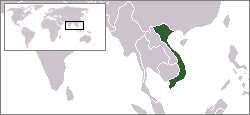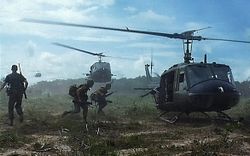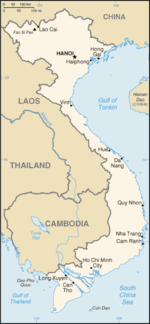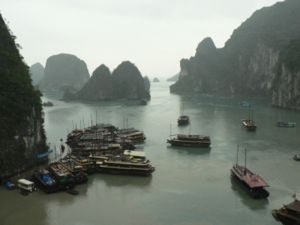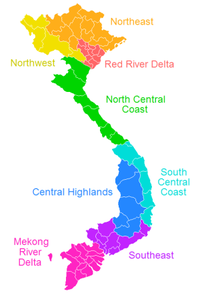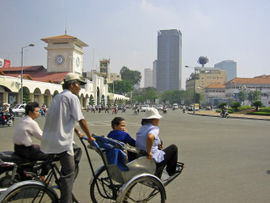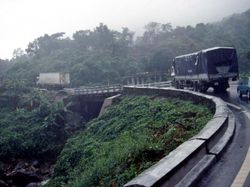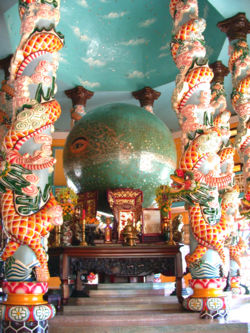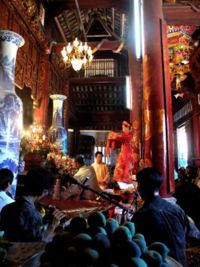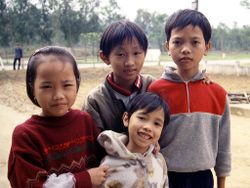Vietnam
2007 Schools Wikipedia Selection. Related subjects: Asian Countries; Countries
| Cộng Hòa Xã Hội Chủ Nghĩa Việt Nam Socialist Republic of Vietnam |
|||||
|
|||||
| Motto: Độc lập – Tự do – Hạnh phúc (Independence, freedom, happiness) |
|||||
| Anthem: Tiến Quân Ca | |||||
| Capital | Hanoi |
||||
|---|---|---|---|---|---|
| Largest city | Ho Chi Minh City | ||||
| Official languages | Vietnamese | ||||
| Government | Socialist republic1 | ||||
| - General Secretary | Nông Đức Mạnh | ||||
| - President | Nguyễn Minh Triết | ||||
| - Prime Minister | Nguyễn Tấn Dũng | ||||
| Independence | From France | ||||
| - Declared | September 2, 1945 | ||||
| - Recognized | 1954 | ||||
| Area | |||||
| - Total | 331,689 km² ( 65th) 128,065 sq mi |
||||
| - Water (%) | 1.3 | ||||
| Population | |||||
| - July 2005 estimate | 84,238,000 ( 12th) | ||||
| - 1999 census | 76,323,173 | ||||
| - Density | 253/km² ( 46th) 655/sq mi |
||||
| GDP ( PPP) | 2005 estimate | ||||
| - Total | $251.8 billion ( 36th) | ||||
| - Per capita | $3,025 ( 123rd) | ||||
| HDI (2003) | 0.704 (medium) ( 108th) | ||||
| Currency | đồng (₫) ( VND) |
||||
| Time zone | ( UTC+7) | ||||
| - Summer ( DST) | ( UTC+7) | ||||
| Internet TLD | .vn | ||||
| Calling code | +84 | ||||
| 1. According to the official name and its 1992 Constitution | |||||
Vietnam ( Vietnamese: Việt Nam), officially the Socialist Republic of Vietnam is a nation in Southeast Asia. It borders the People's Republic of China to the north, Laos to the northwest and Cambodia to the southwest. To the country's east lies the South China Sea. With a population of approximately 84 million, Vietnam is one of the most densely populated nations in Southeast Asia.
History
A famous Vietnamese legend tells that the Vietnamese people of various tribes were born outside the womb following the marriage of Lạc Long Quân (Dragon Chief) and Âu Cơ (the Fairy). However, most Vietnamese historians consider the Dong Son civilization that covered much of Southeast Asia to be the beginning of Vietnam's history. In 208 BCE a Qin general named Triệu Đà established a state called Nam Việt which encompassed southern China and the Red River Delta. The historical significance of the original Nam Việt remains controversial because some historians consider it a Chinese occupation while others believe it was an independent era. For most of the period from 111 BCE to the early 10th century CE, Vietnam was under the rule of successive Chinese dynasties. During this period, Buddhism became a dominant influence in the religious and cultural life of the people. Sporadic independence movements were attempted, but were quickly suppressed by Chinese forces. In 939 CE the Vietnamese defeated Chinese forces at the Bạch Đằng River and gained independence after 10 centuries under Chinese control. They gained complete autonomy a century later. During the rule of the Trần Dynasty, Dai Viet defeated three Mongol attempts of invasion by the Yuan Dynasty. Three times with massive troops as well as careful preparation for their attacks but three times in the row the Mongols were totally swept out of Dai Viet. Incidentally, the final battle in which Vietnamese general Tran Hung Dao defeated most of Mongolian forces was held again at Bạch Đằng River like his ancestors nearly 300 years ago. Feudalism in Vietnam reached its zenith in the Lê Dynasty of the 15th century, especially during the reign of Emperor Le Thanh Tong. Between the 11th and 18th centuries, the Vietnamese expanded southward in a process known as nam tiến (southward expansion). They eventually conquered the kingdom of Champa and much of the Khmer
Vietnam's independence ended in the mid-19th century CE, when the country was colonized by the French Empire. The French administration enacted significant political and cultural changes to Vietnamese society. A Western-style system of modern education was developed, and Christianity was introduced in Vietnamese society. Developing a plantation economy to promote the exports of tobacco, indigo, tea and coffee, the French largely ignored increasing calls for self-government and civil rights. A nationalist political movement soon emerged, and its young leader Ho Chi Minh led its call for independence to the League of Nations. Yet the French maintained dominant control of their colonies until World War II, when the Japanese invasion of Indochina triggered by the war in the Pacific. The natural resources of Vietnam were exploited for the purposes of Japan's military campaigns into Burma, the Malay Peninsula and India. In the final years of the war, a forceful nationalist insurgency emerged under Ho Chi Minh, committed to independence and communism. Following the defeat of Japan, nationalist forces fought French colonial forces in the First Indochina War that lasted from 1945 to 1954. The French suffered a major defeat at the Battle of Dien Bien Phu and shortly afterwards withdrew from the country. The world community divided the country at the 17th parallel into North Vietnam and South Vietnam during the Geneva Accords. This division was meant to be temporary, pending democratic elections and reunification.
Vietnam War
The Communist-held north was opposed by the United States for its proximity to the Soviet Union and Communist China. Disagreements soon emerged over the organizing of elections and reunification, and the U.S. began increasing its contribution of military advisers even as Soviet-supplied arms and munitions strengthened communist forces.
The controversial attack on U.S. ships in the Gulf of Tonkin triggered a U.S. military assault on North Vietnamese military installations and the deployment of more than 500,000 troops into South Vietnam. U.S. forces were soon embroiled in a vicious guerrilla war with the Viet Cong, the South Vietnamese communist militia. North Vietnamese forces unsuccessfully attempted to overrun the South during the 1968 Tet Offensive and the war soon spread into neighboring Laos and Cambodia. With casualties mounting, the U.S. began transferring combat roles to the South Vietnamese military in a process known as Vietnamization. The effort had mixed results, but with US support the South Vietnamese were able to hold their own. The Paris Peace Accords on January 27, 1973 formally recognized the sovereignty of both sides. Under the terms of the accords all American combat troops were withdrawn by March 29, 1973. Limited fighting continued, but all major fighting ended until the North once again invaded in strength and overpowered the South on April 30, 1975. South Vietnam briefly became the Republic of South Vietnam, a puppet state under military occupation by North Vietnam, before being officially reunified with the North under Communist rule as the Socialist Republic of Vietnam on July 2, 1976. More than 30 years of war had devastated the economy, urban and rural infrastructure across the nation. Millions of people were killed, and as many as 50,000 U.S. soldiers were killed in the warfare. Widespread undetonated mines and bombs remain a serious problem for people in the rural areas. Between one and two million people fled the communist regime by sea, becoming famously known as boat people.
Upon taking control, the Vietnamese communists banned other political parties, arrested suspects believed to have collaborated with the U.S. and embarked on a mass campaign of collectivization of farms and factories. Reconstruction of the war-ravaged country was slow and serious humanitarian and economic problems confronted the communist regime. In 1978, the Vietnamese Army invaded Cambodia to remove their erstwhile allies, the Khmer Rouge from power. This action worsened relations with China, which launched a brief incursion into northern Vietnam in 1979. This conflict caused Vietnam to rely even more heavily on Soviet economic and military aid.
With the decline of the Soviet Union and the Cold War, Vietnam's economic woes intensified. In a historic shift in 1986, the Communist Party of Vietnam implemented free-market reforms known as Đổi Mới (Renovation). With the authority of the state remaining unchallenged, private ownership of farms and companies, deregulation and foreign investment were encouraged. The economy of Vietnam has achieved rapid growth in agricultural and industrial production, construction and housing, exports and foreign investment. Vietnam's economic development has been significantly aided by investment from the expatriate Vietnamese community living in the U.S. and European nations. Vietnam normalized relations with the U.S. in 1995, and is an important member state of the Association of South East Asian Nations. The power of the Communist Party over all organs of government remains firm, even though there have been increasing calls for political freedoms from a nascent pro-democracy movement.
Geography and climate
Vietnam extends approximately 331,688 square km (128,066 sq mi) in area. The area of the country running along its international boundaries is 4,639 km (2,883 mi). The topography consists of hills and densely forested mountains, with level land covering no more than 20%. Mountains account for 40% of the area, with smaller hills accounting for 40% and tropical forests 42%. The northern part of the country consists mostly of highlands and the Red River Delta. Phan Xi Păng, located in Lào Cai province, is the highest mountain in Vietnam at 3,143 m (10,312 ft). The south is divided into coastal lowlands, Annamite Chain peaks, extensive forests, and poor soil. Comprising 5 relatively flat plateaus of basalt soil spread over the provinces of Đắk Lắk (or "Dac Lac"), Gia Lai, and Kon Tom, the highlands account for 16% of the country's arable land and 22% of its total forested land. Before 1975, North Vietnam had maintained that the Central Highlands and the Giai Truong Son were strategic areas of paramount importance, essential to the domination not only of South Vietnam but also of the southern part of Indochina. Since 1975, the highlands have provided an area in which to relocate people from the densely populated lowlands.
The delta of the Red River (also known as the Sông Hồng), is a flat, triangular region of 3,000 square kilometers, is smaller but more intensely developed and more densely populated than the Mekong River Delta. Once an inlet of the Gulf of Tonkin, it has been filled in by the enormous alluvial deposits of the rivers over a period of millennia, and it advances one hundred meters into the Gulf annually. The ancestral home of the ethnic Vietnamese, the delta accounted for almost 70 % of the agriculture and 80 % of the industry of North Vietnam before 1975. The Mekong delta, covering about 40,000 square kilometers, is a low-level plain not more than three meters above sea level at any point and criss-crossed by a maze of canals and rivers. So much sediment is carried by the Mekong's various branches and tributaries that the delta advances sixty to eighty meters into the sea every year. An official Vietnamese source estimates the amount of sediment deposited annually to be about 1 billion cubic meters, or nearly 13 times the amount deposited by the Red River. About 10,000 square kilometers of the delta are under rice cultivation, making the area one of the major rice-growing regions of the world. Through the adoption of high yielding, modern rice varieties, Vietnam has become the world’s second largest exporter of rice . Approximately 60% of the irrigated rice growing area in the Mekong Delta is covered with modern rice varieties from the International Rice Research Institute (IRRI) . The southern tip, known as the Cà Mau Peninsula, or Mui Bai Bung, is covered by dense jungle and mangrove swamps.
Vietnam has a tropical monsoon climate, with humidity averaging 84 % throughout the year. However, because of differences in latitude and the marked variety of topographical relief, the climate tends to vary considerably from place to place. During the winter or dry season, extending roughly from November to April, the monsoon winds usually blow from the northeast along the China coast and across the Gulf of Tonkin, picking up considerable moisture; consequently the winter season in most parts of the country is dry only by comparison with the rainy or summer season. During the southwesterly summer monsoon, occurring from May to October, the heated air of the Gobi Desert rises, far to the north, inducing moist air to flow inland from the sea and deposit heavy rainfall. Annual rainfall is substantial in all regions and torrential in some, ranging from 120 centimeters to 300 centimeters. Nearly 90 % of the precipitation occurs during the summer. The average annual temperature is generally higher in the plains than in the mountains and plateaus. Temperatures range from a low of 5°C in December and January, the coolest months, to more than 37°C in April, the hottest month. Seasonal divisions are more clearly marked in the northern half than in the southern half of the country, where, except in some of the highlands, seasonal temperatures vary only a few degrees, usually in the 21°C-28°C range.
Government and politics
The Socialist Republic of Vietnam is a single-party state. A new state constitution was approved in April 1992, replacing the 1975 version. The central role of the Communist Party was reasserted in all organs of government, politics and society. Only political organizations affiliated or endorsed by the Communist Party are permitted to contest elections. These include the Vietnamese Fatherland Front, workers and trade unionist parties. Although the state remains officially committed to socialism as its defining creed, the ideology's importance has substantially diminished since the 1990s. The President of Vietnam is the titular head of state and the nominal commander in chief of the military of Vietnam, chairing the Council on National Defense and Security. The Prime Minister of Vietnam is the head of government, presiding over a council of ministers composing of 3 deputy prime ministers and the heads of 26 ministries and commissions.
The National Assembly of Vietnam is the unicameral legislature of the government, composed of 498 members. It is superior to both the executive and judicial branches. All members of the council of ministers are derived from the National Assembly. The Supreme People's Court of Vietnam, which is the highest court of appeal in the nation is also answerable to the National Assembly. Beneath the Supreme People's Court stand the provincial municipal courts and the local courts. Military courts are also a powerful branch of the judiciary with special jurisdiction in matters of national security. All organs of Vietnam's government are largely controlled by the Communist Party. Most government appointees are members of the party. The General Secretary of the Communist Party is perhaps one of the most important political leaders in the nation, controlling the party's national organization, state appointments and setting policy.
The Vietnam People's Army is the official name for the three military services of Vietnam, which is organized on the lines of China's People's Liberation Army. The VPA is further subdivided into the Vietnamese People's Ground Forces (including Strategic Rear Forces and Border Defense Forces), the Vietnam People's Navy, the Vietnam People's Air Force and the coast guard. Through Vietnam's recent history, the VPA has actively been involved in Vietnam's workforce to develop the economy of Vietnam, in order to coordinate national defense and the economy. The VPA is involved in such areas as industry, agriculture, forestry, fishery and telecommunications. The total strength of the VPA is close to 500,000 soldiers. The government also organizes and maintains provincial militias and police forces. The role of the military in public life has steadily weakened since the 1980s.
Subdivisions
The capital of Vietnam is Hanoi (it had served as the capital of North Vietnam), and the largest and most populous city is the Ho Chi Minh City (formerly known as Saigon, it had served as the capital of South Vietnam). Vietnam is subdivided into 64 provinces, which are further subdivided into districts and municipalities. Vietnamese provinces are in theory controlled by a People's Council, elected by the inhabitants. The People's Council appoints a People's Committee, which acts as the executive arm of the provincial government. This arrangement is a somewhat simplified version of the situation in Vietnam's national government. Provincial governments are expected to be subordinate to the central government. Often, the Vietnamese government groups the various provinces into eight regions. These regions are not always used, and alternative classifications are possible:
- Northwest ( Tay Bac) contains four inland provinces in the west of Vietnam's northern part. Two of them are along Vietnam's border with Laos, and one borders China.
- Northeast ( Dong Bac) contains eleven provinces that lie to north of the highly populated Red River lowlands. Many of these provinces are mountainous.
- Red River Delta ( Dong Bang Song Hong) contains the small but populous provinces based around the Red River. There are nine provinces in this region. It also includes the national capital, Hanoi, and the municipality of Haiphong — both are independent of any provincial government.
- North Central Coast ( Bac Trung Bo) contains six provinces in the northern half of Vietnam's narrow central part. All provinces in this region stretch from the coast in the east to Laos in the west.
- South Central Coast ( Nam Trung Bo) contains five coastal provinces in the southern half of Vietnam's central part. Vietnam is wider at this point than in the North Central Coast region, and so the inland areas are separate provinces. The region also includes the independent municipality of Danang.
- Central Highlands ( Tay Nguyen) contains the five inland provinces of south-central Vietnam. Much of this region is mountainous, while mostly inhibited by ethnic minorities, there are many Vietnamese living here.
- Southeast ( Dong Nam Bo) contains those parts of lowland southern Vietnam which are north of the Mekong delta. There are seven provinces, plus the municipality of Ho Chi Minh City (formerly Saigon).
- Mekong River Delta ( Dong Bang Song Cuu Long) is Vietnam's southernmost region, mostly containing small but populous provinces in the delta of the Mekong. There are twelve provinces, plus the municipality of Can Tho.
Economy
The Vietnam War destroyed much of the economy of Vietnam. Apart from widespread destruction of urban and rural infrastructure, heavy bombings and mines had savaged agricultural activities. Millions of people were displaced by the conflict, and over two million people were killed. Upon taking power, the Government created a command economy in the nation. Collectivization of farms, factories and economic capital was implemented, and millions of people were put to work in government programs. For many decades, Vietnam's economy was plagued with inefficiency and corruption in state programs, poor quality and underproduction and restrictions on economic activities and trade. It also suffered from the trade embargo from the United States and most of Europe after the Vietnam War. Furthermore, the trade partners of the Communist blocs began to erode. In 1986, the Sixth Party Congress introduced significant economic reforms with market economy elements as part of a broad economic reform package called " đổi mới" (Renovation). Private ownership was encouraged in industries, commerce and agriculture. In many ways, this followed the Chinese model and achieved similar results. On one hand, Vietnam achieved around 8% annual GDP growth from 1990 to 1997 and continued at around 7% from 2000 to 2002, making it the world's second-fastest growing economy. Simultaneously, foreign investment grew three-fold and domestic savings quintupled. Manufacturing, information technology and high-tech industries form a large and fast-growing part of the national economy.
Urban unemployment has been rising steadily in recent years due to high numbers of migration from the countryside to the cities, and rural unemployment, estimated to be up to 35% during non-harvest periods, is already at critical levels. Layoffs in the state sector and foreign-invested enterprises, combined with the lasting effects of a previous military demobilization, further exacerbated the unemployment situation. In May 2006, Vietnam negotiated a bilateral trade agreement with the U.S. that marked the completion of the bilateral negotiations with WTO members the country needed to qualify for accession to the organization. Among other steps taken in the process of transitioning to a market economy, Vietnam in July 2006 updated its intellectual property legislation to comply with TRIPS. Vietnam's chief trading partners include Japan, Australia, ASEAN countries, the U.S. and Western European nations. Vietnam was accepted into the WTO on November 7, 2006.
| Year | Gross Domestic Product (Billion VND) | US Dollar Exchange |
|---|---|---|
| 1980 | 57,130 | 2.05 Old Dong |
| 1985 | 100,464 | 6.69 New Dong |
| 1990 | 41,955,000 | 6,482.54 New Dong |
| 1995 | 228,892,000 | 11,037.85 New Dong |
| 2000 | 441,646,000 | 14,169.85 New Dong |
| 2005 | 806,854,877 | 15,851.76 New Dong |
Vietnam is still a relatively poor country with GDP of US$251.8 billion (est., 2004). This translates to ~US$3000 per capita. Inflation rate was estimated at 14% per year in 2004. The government has contained this figure to 9.5% in 2005, and continues its efforts to avoid double digit inflation. The spending power of the public has noticeably increased. The reason lies in the high prices for property. In the capital of Hanoi, property prices can be as high as those in Tokyo or New York City. This has amazed many people because the average income per capita of this city is around US$1,000 per annum. The booming prices have given poor land owners the opportunity to sell their homes for inflated prices. Tourism has become an increasingly important industry in Vietnam. There are over 3 to 3.5 million annual visitors. Expatriate Vietnamese are an important source of financial and capital investment.
As a result of several land reform measures, Vietnam is now the largest producer of cashew nuts with a one-third global share and second-largest rice exporter in the world. Vietnam has the highest percent of land use for permanent crops, 6.93%, of any nation in the Greater Mekong Subregion . Besides rice, key exports are coffee, tea, rubber, and fishery products. However, agriculture's share of economic output has declined, falling as a share of GDP from 42% in 1989 to 26% in 1999, as production in other sectors of the economy has risen.
Transport
The modern transport network of Vietnam was originally developed under French rule for the purpose of raw materials harvesting, and reconstructed and extensively modernized following the Vietnam War. The railways are the most popular form of transportation in the country. The state-operated Vietnam Railways manages train services on the 2,654 kilometers of railway lines. Vietnam boasts 93,300 kilometers of roads, which connect all cities, towns and many rural areas. Roads in smaller towns and rural areas are poorly maintained and largely unpaved, but all major cities have a well-developed network of highways. Economic growth has led to greater public and private investment in the improvement and construction of more roads and highways. Bicycles, motorcycles and public bus services remain the most popular form of road transport in Vietnam's cities, towns and villages. Traffic congestion is a serious problem in Hanoi and Ho Chi Minh City as the city's roads struggle to cope with the booming numbers of automobiles.
There are also more than 17,000 kilometers of navigable waterways, which play a significant role in rural life owing to the extensive network of rivers in Vietnam. The nation has 7 developed ports and harbours at Cam Ranh, Da Nang, Hai Phong, Ho Chi Minh City, Hong Gai, Qui Nhon and Nha Trang. There are increasing demands and pressures on the government to attract foreign investment in modernizing Vietnam's ports, owing to an explosion of trade and cargo. Vietnam has four international airports, of which the Tan Son Nhat International Airport in Ho Chi Minh City is the largest and busiest. There are also many regional airports, and smaller, non-commercial airports and airstrips run by the government and military. Vietnam Airlines is the flagship national carrier, managed entirely by the state. The Pacific Airlines is a smaller service run by state-owned firms that was formed to invite foreign investment in aviation and expand air links to destinations in the Asia Pacific.
Demographics
| Ethnic composition of Vietnam | ||||
|---|---|---|---|---|
| Viet/Kinh | 86.21% | |||
| Tay | 1.94% | |||
| Thai | 1.74% | |||
| Mường | 1.49% | |||
| Khmer | 1.38% | |||
| Hoa | 1.13% | |||
| Nung | 1.12% | |||
| Hmong | 1.03% | |||
The 1999 census estimates the population of Vietnam to be 76.3 million, and recent estimates place the figure beyond 84 million. The largest of the 54 government recognized ethnic groups of Vietnam were:
- Viet/ Kinh: 65.8 million (86.21%)
- Tay: 1.48 million (1.94%)
- Thái: 1.33 million (1.74%)
- Mường: 1.14 million (1.49%)
- Khmer: 1.06 million (1.38%)
- Hoa: 0.862 million (1.13%)
- Nung: 0.856 million (1.12%)
- Hmong: 0.787 million (1.03%)
Vietnamese people form the largest ethnic group, and are also called Viet or Kinh. Their population is concentrated in the alluvial deltas and coastal plains of the country. A homogenous social group, the Viets exert influence on national life through their control of political and economic affairs and their role as purveyors of the dominant culture. By contrast, the ethnic minorities, except for the Khơ-me Crôm (Khmer Krom) and the Hoa (ethnic Han Chinese), are found mostly in the highlands that cover two-thirds of the national territory. The Mường live in the mountains of north central Vietnam and speak a Mon-Khmer language closely-related to the Vietnamese language. The Tày people live primarily in the mountains and foothills of northern Vietnam. Their language is a member of the Tai languages, belonging to the Central Tai subgroup and closely related to the Zhuang language of southern China. The Khơ-me Crôm live in the fertile delta of the Mekong River in southern Vietnam and are ethnically the same as the Khmer people who make up the majority of the population of Cambodia.
The Hoa (ethnic Han Chinese) are mainly lowlanders and, more specifically, urban dwellers. They speak predominantly Cantonese (known to the Vietnamese as Quảng Đông 廣東), but there are also speakers of Hakka (Khách Gia 客家), Min Nan/ Hokkien/ Fujian (Mân Nam 閩南/Phúc Kiến 福建), Chaozhou (Triều Châu 潮州), etc. Until the 1979 Vietnamese census, the Hoa were the largest minority of Vietnam. Since 1975, many Hoa communities have left Vietnam, so that according to the 1999 census the Hoa were only the fifth-largest minority. Vietnam also has some Eurasians from the French colonization and Amerasian of American soldiers and personnel. Furthermore, there are also a few of those descended from Indian settlers also during the colonial era. Many biracial people face extensive discrimination in Vietnam, being often referred to as "Children of the Dust."
According to official figures, 86.2% of the population speak Vietnamese as a native language. Various other languages are spoken by the several minority groups in Vietnam. The most spoken of these languages are: Tày ( 1.5 million), Mường (1.2 million), Khmer (1.05 million), Chinese (870,000, this figure also includes speakers of all Chinese dialects), Nùng (860,000), H'Mông (790,000), and Tai Dam (700,000). The French language, a legacy of colonial rule is still spoken by some older Vietnamese as a second language but is losing its popularity. Russian — and to a much lesser extent Czech or Polish — is often known among those whose families had ties with the Soviet bloc. In recent years, Chinese, Japanese and English have become the most popular foreign languages, with English being obligatory courses in most schools.
For much of Vietnamese history, Mahayana Buddhism, Taoism and Confucianism have strongly influenced the religious and cultural life of the people. The communist government's suppression of religious activities have affected the practice of organized religions. According to the 1999 census, 80.8% of Vietnamese subscribe to no religion. Christianity was introduced by French colonists, and to a lesser extent during the presence of American forces. There is a substantial following of Roman Catholicism and Protestantism amongst the Cao Đài, and Hoa Hao communities. The largest Protestant churches are the Evangelical Church of Vietnam and the Montagnard Evangelical Church. Membership of Sunni and Bashi Islam is usually accredited to the ethnic Cham minority, but there are also a few ethnic Vietnamese adherents of Islam in the southwest.
The Vietnamese government has had a history of violence toward local religious leaders regarding freedom of worship. It has consistently repressed religious sects that are not sanctioned by the state. These religious groups include Unified Buddhist Church of Vietnam, Hoa Hao Buddhist Church, and Montagnard protestant churches such as Mennonite, according to a 2003 European Parliament resolution . Most notably, the Most Venerable Thich Huyen Quang, 86, of the UBCV has been imprisoned for more than 25 years after he had written a letter of protest to Prime Minister Pham Van Dong.
Vietnamese government violations in 2005 include detainee interrogation, abuse, harassment, and death threats according to the Centre for Religious Freedom .
However, recent improvement of liberty in religion in Vietnam has made the United State government to remove the country from the list of Country of Particular Concern .
Culture
Over thousands of years, the culture of Vietnam has been strongly influenced by neighbouring China. Due to Vietnam's long association with China, Vietnamese culture remains strongly Confucian with its emphasis on familial duty. Education is highly valued. Historically, passing the imperial Mandarin exams was the only means for Vietnamese people to socially advance themselves.
In the socialist era, the cultural life of Vietnam has been deeply influenced by government-controlled media and the cultural influences of socialist programs. For many decades, foreign cultural influences were shunned and emphasis placed on appreciating and sharing the culture of communist nations such as the Soviet Union, China, Cuba and others. Since the 1990s, Vietnam has seen a greater exposure to Southeast Asian, European and American culture and media.
The traditional female costume called " Áo Dài" is worn in special occasions such as weddings or Lunar New Year celebration or festivals. Áo Dài was once worn by both genders but today it is worn mainly by females.
Vietnamese cuisine uses very little oil and many vegetables. The main dishes are often based on rice, soy sauce, and fish sauce. Its characteristic flavours are sweet (sugar), spicy (serrano peppers), sour (lime), umami (fish sauce), and flavored by a variety of mint and basil.
Vietnamese music is slightly different according to three regions: Bắc or North, Trung or Central, and Nam or South. Northern classical music is Vietnam's oldest and is traditionally more formal. Vietnamese classical music can be traced to the Mongol invasions, when the Vietnamese captured a Chinese opera troupe. Central classical music shows the influences of Champa culture with its melancholic melodies. Southern music exudes a lively laissez-faire attitude.
Football is the most popular sport in Vietnam. Sports and games such as badminton, tennis, ping pong and chess are also popular with large segments of the population. Baseball, introduced during American presence in Vietnam, has also gained some popularity. The (expatriate Vietnamese) community forms a prominent part of Vietnamese cultural life, introducing Western sports, films, music and other cultural activities in the nation.
Vietnam is home to a small film industry, but the works from its counterparts in Hong Kong, France, the U.S. enjoy greater popularity and circulation.
Language
In its early history, Vietnamese writing used Chinese characters. In the 13th century, the Vietnamese developed their own set of characters called Chữ nôm. The celebrated epic Đoạn trường tân thanh (Truyện Kiều or The Tale of Kieu) by Nguyễn Du was written in Chữ nôm. During the French colonial period, Quốc ngữ, the romanised Vietnamese alphabet representation of spoken Vietnamese which was a collective fruit of several Portuguese missionaries, became popular and brought literacy to the masses.
Education
Vietnam has an extensive state-controlled network of schools, colleges and universities. General education in Vietnam is imparted in 5 categories: pre-primary ( Kindergarten), primary schools, intermediate schools, high schools and colleges. Courses are taught mainly in Vietnamese, but also often in French or English. A large number of public schools have been organized across cities, towns and villages with the purpose of raising the national literacy rate. According to Vietnam's Ministry of Education and Training, there are currently 23 non-public universities, accounting for 11% of the total number of universities. These non-public universities offer seats for 119,464 students, or 11.7% of the total number of students. There are a large number of specialist colleges, established to develop a diverse and skilled national workforce. A large number of Vietnam's most acclaimed universities are based in Ho Chi Minh City and Hanoi.
In the year 2004, nearly 1 million Vietnamese students took the university entrance exam (considered a pass-or-fail test), but the entire higher education system of Vietnam had space for only 200,000 students. The government is planning to increase the number of non-public universities to 30% by 2007. Despite state emphasis on education, many Vietnamese schools suffer from overcrowding, a shortage of trained teaching staff, funding and resources. There are a small number of private schools, emerging mainly in the cities. The entire education system is facing several crises such as out-of-date course curriculum, a lecturer-centered method of teaching and learning, research activities separated from teaching activities and a major gap between theory and practice that leads to a large number of graduates being unable to find a job. Degrees from Vietnamese universities are often not accredited by institutions recognized around the world.


